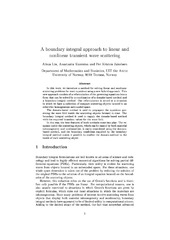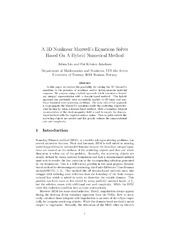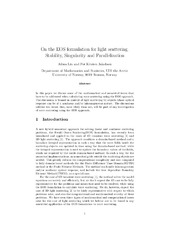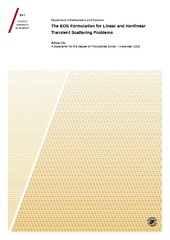| dc.contributor.advisor | Jakobsen, Per | |
| dc.contributor.author | Lin, Aihua | |
| dc.date.accessioned | 2019-04-16T10:57:57Z | |
| dc.date.available | 2019-04-16T10:57:57Z | |
| dc.date.issued | 2019-03-29 | |
| dc.description.abstract | This thesis developed the EOS formulations of solving nonlinear transient scatterings, both for 1D case and 3D Maxwell's equations. This method can be accurately and stably implemented using one particular choice of numerical scheme for the inside of the objects and for the required integral representations of the boundary values. For a stable numerical solution, the time step needs to be confined in some range, where we have found that for 1D case, this range is determined by the internal domain-based method while for the 3D case, this range is both determined by the the internal domain-based method and the boundary integral part. Specifically, in 3D case, the lower limit of the interval is highly depended on the properties of the materials while the upper limit is determined by the internal domain-based method. This finding is believed to be related with the popular late time stabilities in community of computational electromagnetics. | en_US |
| dc.description.doctoraltype | ph.d. | en_US |
| dc.description.popularabstract | This thesis developed the EOS formulations of solving nonlinear transient scatterings, both for 1D case and 3D Maxwell's equations. This method can be accurately and stably implemented using one particular choice of numerical scheme for the inside of the objects and for the required integral representations of the boundary values. For a stable numerical solution, the time step needs to be confined in some range, where we have found that for 1D case, this range is determined by the internal domain-based method while for the 3D case, this range is both determined by the the internal domain-based method and the boundary integral part. Specifically, in 3D case, the lower limit of the interval is highly depended on the properties of the materials while the upper limit is determined by the internal domain-based method. This finding is believed to be related with the popular late time stabilities in community of computational electromagnetics. | en_US |
| dc.identifier.isbn | 978-82-8236-342-6 (trykt) og 978-82-8236-343-3 (pdf) | |
| dc.identifier.uri | https://hdl.handle.net/10037/15213 | |
| dc.language.iso | eng | en_US |
| dc.publisher | UiT Norges arktiske universitet | en_US |
| dc.publisher | UiT The Arctic University of Norway | en_US |
| dc.relation.haspart | <p>Paper 1: Lin, A., Kuzmina, A. & Jakobsen, P.K. (2018). A boundary integral approach to linear and nonlinear transient wave scattering. (Submitted manuscript). Also available at <a href=https://arxiv.org/abs/1807.01142> https://arxiv.org/abs/1807.01142. </a> <p>
<p>Paper 2: Lin, A. & Jakobsen, P. A 3D Nonlinear Maxwell’s Equations Solver Based On A Hybrid Numerical Method. (Submitted manuscript). "This is an author-created, un-copyedited version of an article accepted for publication/published in Physica Scripta. IOP Publishing Ltd is not responsible for any errors or omissions in this version of the manuscript or any version derived from it. The Version of Record is available online at <a href=https://doi.org/10.1088/1402-4896/ab166d>https://doi.org/10.1088/1402-4896/ab166d." </a><p>
<p>Paper 3: Lin, A. & Jakobsen, P.K. (2018). On the EOS formulation for light scattering. Stability, Singularity and Parallelization. (Submitted manuscript). Also available at <a href= https://arxiv.org/abs/1812.05136> https://arxiv.org/abs/1812.05136. </a><p> | en_US |
| dc.rights.accessRights | openAccess | en_US |
| dc.rights.holder | Copyright 2019 The Author(s) | |
| dc.rights.uri | https://creativecommons.org/licenses/by-nc-sa/3.0 | en_US |
| dc.rights | Attribution-NonCommercial-ShareAlike 3.0 Unported (CC BY-NC-SA 3.0) | en_US |
| dc.subject | VDP::Mathematics and natural science: 400::Mathematics: 410 | en_US |
| dc.subject | VDP::Matematikk og Naturvitenskap: 400::Matematikk: 410 | en_US |
| dc.title | The EOS Formulation for Linear and Nonlinear Transient Scattering Problems | en_US |
| dc.type | Doctoral thesis | en_US |
| dc.type | Doktorgradsavhandling | en_US |


 English
English norsk
norsk




